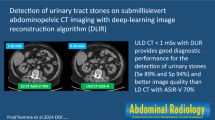Abstract
Background
Deep learning Computed Tomography (CT) reconstruction (DLR) algorithms promise to improve image quality but the impact on clinical diagnostic performance remains to be demonstrated. We aimed to compare DLR to standard iterative reconstruction for detection of urolithiasis by unenhanced CT in children and young adults.
Methods
This was an IRB approved retrospective study involving post-hoc reconstruction of clinically acquired unenhanced abdomen/pelvis CT scans. Images were reconstructed with six different manufacturer-standard DLR algorithms and reformatted in 3 planes (axial, sagittal, and coronal) at 3 mm intervals. De-identified reconstructions were loaded as independent examinations for review by 3 blinded radiologists (R1, R2, R3) tasked with identifying and measuring all stones. Results were compared to the clinical iterative reconstruction images as a reference standard. IntraClass correlation coefficients and kappa (k) statistics were used to quantify agreement.
Results
CT data for 14 patients (mean age: 17.3 ± 3.4 years, 5 males and 9 females, weight class: 31-70 kg (n = 6), 71-100 kg (n = 7), > 100 kg (n = 1)) were reconstructed into 84 total exams. 7 patients had urinary tract calculi. Interobserver agreement on the presence of any urinary tract calculus was substantial to almost perfect (k = 0.71–1) for all DLR algorithms. Agreement with the reference standard on number of calculi was excellent (ICC = 0.78–0.96) and agreement on the size of the largest calculus was fair to excellent (ICC = 0.51–0.97) depending on reviewer and DLR algorithm.
Conclusion
Deep learning reconstruction of unenhanced CT images allows similar renal stone detectability compared to iterative reconstruction.
Graphic abstract



Similar content being viewed by others
References
Miah T, Kamat D (2017) Pediatric Nephrolithiasis: A Review. Pediatr Ann 46(6):e242–e244. https://doi.org/10.3928/19382359-20170517-02
Brisbane W, Bailey MR, Sorensen MD (2016) An overview of kidney stone imaging techniques. Nat Rev Urol 13(11):654–662. https://doi.org/10.1038/nrurol.2016.154
Hong JY, Lee DH, Chang IH, Park SB, Kim CW, Chi BH (2018) Inter-observer Agreement between Urologists and Radiologists in Interpreting the Computed Tomography Images of Emergency Patients with Renal Colic. Urol J 15 (2):6–9. https://doi.org/10.22037/uj.v0i0.3906
Bowen DK, Tasian GE (2018) Pediatric Stone Disease. Urol Clin North Am 45(4):539–550. https://doi.org/10.1016/j.ucl.2018.06.002
Li LL, Wang H, Song J, Shang J, Zhao XY, Liu B (2021) A feasibility study of realizing low-dose abdominal CT using deep learning image reconstruction algorithm. J Xray Sci Technol. https://doi.org/10.3233/XST-200826
Ichikawa Y, Kanii Y, Yamazaki A, Nagasawa N, Nagata M, Ishida M, Kitagawa K, Sakuma H (2021) Deep learning image reconstruction for improvement of image quality of abdominal computed tomography: comparison with hybrid iterative reconstruction. Jpn J Radiol. https://doi.org/10.1007/s11604-021-01089-6
Cao L, Liu X, Li J, Qu T, Chen L, Cheng Y, Hu J, Sun J, Guo J (2021) A study of using a deep learning image reconstruction to improve the image quality of extremely low-dose contrast-enhanced abdominal CT for patients with hepatic lesions. Br J Radiol 94(1118):20201086. https://doi.org/10.1259/bjr.20201086
Tatsugami F, Higaki T, Nakamura Y, Yu Z, Zhou J, Lu Y, Fujioka C, Kitagawa T, Kihara Y, Iida M, Awai K (2019) Deep learning-based image restoration algorithm for coronary CT angiography. Eur Radiol 29(10):5322–5329. https://doi.org/10.1007/s00330-019-06183-y
Brady SL, Trout AT, Somasundaram E, Anton CG, Li Y, Dillman JR (2021) Improving Image Quality and Reducing Radiation Dose for Pediatric CT by Using Deep Learning Reconstruction. Radiology 298(1):180–188. https://doi.org/10.1148/radiol.2020202317
Coursey CA, Casalino DD, Remer EM, Arellano RS, Bishoff JT, Dighe M, Fulgham P, Goldfarb S, Israel GM, Lazarus E, Leyendecker JR, Majd M, Nikolaidis P, Papanicolaou N, Prasad S, Ramchandani P, Sheth S, Vikram R (2012) ACR Appropriateness Criteria(R) acute onset flank pain–suspicion of stone disease. Ultrasound Q 28(3):227–233. https://doi.org/10.1097/RUQ.0b013e3182625974
Landis JR, Koch GG (1977) The measurement of observer agreement for categorical data. Biometrics 33(1):159–174
Hallgren KA (2012) Computing Inter-Rater Reliability for Observational Data: An Overview and Tutorial. Tutor Quant Methods Psychol 8 (1):23–34. https://doi.org/10.20982/tqmp.08.1.p023
Singh R, Digumarthy SR, Muse VV, Kambadakone AR, Blake MA, Tabari A, Hoi Y, Akino N, Angel E, Madan R, Kalra MK (2020) Image Quality and Lesion Detection on Deep Learning Reconstruction and Iterative Reconstruction of Submillisievert Chest and Abdominal CT. AJR Am J Roentgenol 214(3):566–573. https://doi.org/10.2214/AJR.19.21809
Jin DH, Lamberton GR, Broome DR, Saaty H, Bhattacharya S, Lindler TU, Baldwin DD (2009) Renal stone detection using unenhanced multidetector row computerized tomography–does section width matter? J Urol 181(6):2767–2773. https://doi.org/10.1016/j.juro.2009.01.092
Kluner C, Hein PA, Gralla O, Hein E, Hamm B, Romano V, Rogalla P (2006) Does ultra-low-dose CT with a radiation dose equivalent to that of KUB suffice to detect renal and ureteral calculi? J Comput Assist Tomogr 30(1):44–50. https://doi.org/10.1097/01.rct.0000191685.58838.ef
Roberts MJ, Williams J, Khadra S, Nalavenkata S, Kam J, McCombie SP, Arianayagam M, Canagasingham B, Ferguson R, Khadra M, Varol C, Winter M, Sanaei F, Loh H, Thakkar Y, Dugdale P, Ko R (2020) A prospective, matched comparison of ultra-low and standard-dose computed tomography for assessment of renal colic. BJU Int 126(Suppl 1):27–32. https://doi.org/10.1111/bju.15116
Rodger F, Roditi G, Aboumarzouk OM (2018) Diagnostic Accuracy of Low and Ultra-Low Dose CT for Identification of Urinary Tract Stones: A Systematic Review. Urol Int 100(4):375–385. https://doi.org/10.1159/000488062
Noda Y, Kaga T, Kawai N, Miyoshi T, Kawada H, Hyodo F, Kambadakone A, Matsuo M (2021) Low-dose whole-body CT using deep learning image reconstruction: image quality and lesion detection. Br J Radiol:20201329. https://doi.org/10.1259/bjr.20201329
Zeng L, Xu X, Zeng W, Peng W, Zhang J, Sixian H, Liu K, Xia C, Li Z (2021) Deep learning trained algorithm maintains the quality of half-dose contrast-enhanced liver computed tomography images: Comparison with hybrid iterative reconstruction: Study for the application of deep learning noise reduction technology in low dose. Eur J Radiol 135:109487. https://doi.org/10.1016/j.ejrad.2020.109487
Author information
Authors and Affiliations
Corresponding author
Additional information
Publisher's Note
Springer Nature remains neutral with regard to jurisdictional claims in published maps and institutional affiliations.
Rights and permissions
About this article
Cite this article
Thapaliya, S., Brady, S.L., Somasundaram, E. et al. Detection of urinary tract calculi on CT images reconstructed with deep learning algorithms. Abdom Radiol 47, 265–271 (2022). https://doi.org/10.1007/s00261-021-03274-7
Received:
Revised:
Accepted:
Published:
Issue Date:
DOI: https://doi.org/10.1007/s00261-021-03274-7




